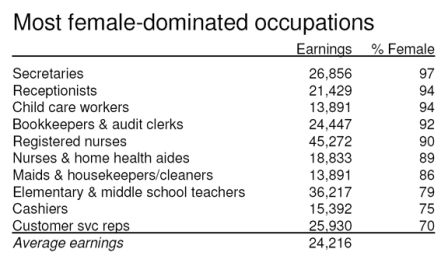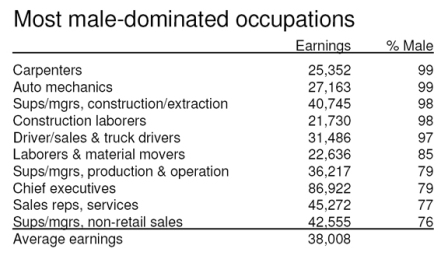Today's most emailed story at the New York Times is Tuesday's report on how economic hard times are affecting women's employment rates: "After moving into virtually every occupation, women are being afflicted on a large scale by the same troubles as men: downturns, layoffs, outsourcing, stagnant wages or the discouraging prospect of an outright pay cut. And they are responding as men have, by dropping out or disappearing for a while."
Although unhappy about hard times -- I don't mean to doubt anyone's sincerity -- this is perversely good news for the feminist argument that there is no "opt-out revolution" of post-feminist women embracing motherhood and heading for home. (The facts here are not new, as Elma Gilbey Keller points out.)
But back up to the first part of that quote: "After moving into virtually every occupation..." That is literally true but highly exaggerated in reality. For tens of millions of regular workers, men and women work different jobs (These are my calculations for full-time, full-year workers in 2004).

Women's jobs happen to be mostly about care work: health care, childcare, and interpersonal relations - and they pay less than men's jobs, which are blue-collar jobs or positions of authority, and pay more:

From top to bottom, the vast majority of men and women work in different jobs. Consider:
1. There was a strong trend of occupational desegregation, but the pace of that change slowed markedly in the 1990s.
2. Women in management are relatively few, and the pace of progress has slowed. According to an analysis of Equal Employment Opportunity Commission reports by me and Matt Huffman, among all medium and large private sector establishments, 35% of managerial workers were women in 2005, and by all measures the pace of improvement slowed in the last 10 years.
3. We also reported that, according to Catalyst data, at the very top, women hold just 14.7% of Fortune 500 corporate director seats and officer positions. That is big progress from the 2.3% in 1984, but most of those gains occurred before 1995.
Some of these differences could reflect the cold hard facts of biology, women's choices, strength differences, and so on: but nurse aides and truck drivers require the same amount of education and strength, and trick drivers earn 40% more - that's almost 4 million workers in those two occupations alone. And two more problems: why would it have changed so much in the 1970s and 1980s, and why would it be so different in different countries?
Whatever its causes, the segregation of men and women at work is harmful to women's economic and social equality and history shows it is subject to change, if we want it.